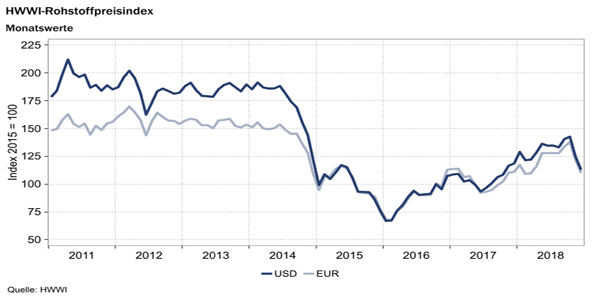In December, HWWI Commodity Price Index dropped again
- HWWI Commodity Price Index fell by 9.5% (US dollar base).
- On monthly average, crude oil price decreased by 10.3%.
- Sub-Indices for Industrial and Food & beverages dropped also.
(Hamburg)In December, the HWWI Total commodity price index fell by 9.5% (in Euro: – 9.6%). Thus, commodity prices declined in the last month of the year 2018 again significantly, even though less strong than in November. The HWWI Total index fell to 112.9 points (in Euro: 110.0 points), which is 4.8% (in Euro: – 1.0%) lower than a year ago. The Index for Energy raw materials repeatedly showed the strongest loss. It fell on average by 10.5% (in Euro: – 10.6%) in the last month of the year 2018. The Index for Industrial raw materials dropped more than in the previous month and fell by 2.6% (in Euro: – 2.8%) in December. The Index for food and beverages fell by 0.9% (in Eu-ro: – 1.0%). It represented the smallest price decline of the three sub-indices. The index without energy dropped by 2.0% (in Euro: – 2.2%) to 104.8 points (in Euro: 102.2 points). Concerns about a weaker global economy still burdened the commodi-ty markets. The lingering trade dispute between the United States and China, as well as between the United States and the EU dampens expectations for the growth pro-spects of economies. The uncertainty about the consequences of the conflict strained global commodity demand and as a result prices, especially in the crude oil market, declined.
Index for energy raw materials: – 10.5% (in Euro: – 10.6%)
The Index for Energy raw materials represents the fossil commodities: crude oil, nat-ural gas and thermal coal. In December, the monthly average price for crude oil dropped by 12.6% (in Euro: – 12.7%) to 54.76 US dollar (in Euro: 48.11) per barrel. Thus, in December 2018 the average price for crude oil was lower by 10.3% (in Euro: – 12.7%) then the price in December 2017.In the beginning of December, the OPEC with its allied non-OPEC countries including Russia (OPEC +) had agreed on a re-duction of the crude oil production rate to stop the ongoing decline in the crude oil market since October.However, the price of crude oil continued to fall, because there was a disagreement by the market stakeholders whether these cuts in the future would be sufficient to eliminate the oversupply in the oil market. Furthermore, on December 13th, 2018 the International Energy Agency (IEA) warned in its monthly report about a crude oil oversupply in the world market. In the past, stocks were built due to the relatively low crude oil prices, which could further contribute to the crude oil sup-ply in the next few months. In addition, lowered economic outlook in China and Eu-rope, as well as a general concern about a deteriorating world economy impacted global demand for crude oil. The monthly average prices of benchmark crude oils developed as follows: the price of American crude oil, West Texas intermediate (WTI), dropped by 13.0% (in Euro: – 13.1%), the price for crude oil from the Middle East,benchmark Dubai fell by 12.8% (in Euro: – 12.9%) and the price of the European crude oil, benchmark Brent fell by 12.1% (in Euro: – 12.2%). In December all three prices recorded significantly below the price level of December of the previous year.
The price of natural gas declined on monthly average by 4.2% (in Euro: – 4.4%) in December. In detail, it was observed that the price of European natural gas fell again. It declined by 4.4% (in Euro: – 4.6%). After American natural gas recorded significant price increases in the last few months, it fell by 4.0% (in Euro: – 4.2%) on monthly average in December. The monthly average price of coal slightly decreased by 0.4% (in Euro: – 0.6%). The Index for Energy raw materials fell by 10.5% (in Euro: – 10.6%) to 114.2 points (in Euro: 111.3 points).

Index for Industrial raw materials: – 1.0% (in Euro: ±0. 0%)
The Index for industrial raw materials is divided in three sub-indices: the Index forAgriculture raw materials, the Index for Non-ferrous metals as well as the Index for Iron ore and steel scrap. The Index for Agricultural raw materials fell by 0.5% (in Euro: -0.6%). Repeatedly, the Index of Non-ferrous metals fell on a monthly average. Pric-es in December developed differently for the Non-ferrous metals listed in the index. The lowest price decline was observed for aluminum. The price of aluminum fell by -0.3% (in Euro: -0.5%), with the copper price falling the second highest. Copper was down by -1.6% (in Euro: -1.8%). As in November, the price of nickel dropped the most. Among other things, nickel is needed for the refinement of steel. A high supply of nickel and falling demand for steel as a result of the current trade dispute between China and the US caused the price of nickel to fall by -3.8% (-4.0% in Euro). By con-trast, prices for lead, zinc and tin rose on a monthly average. Lead increased by 1.2% (in Euro: +1.0%). The price of zinc rose by 1.1% (in Euro: + 0.9%). The lowest price increase was recorded for tin. The price of tin rose only by +0.5% (in Euro: +0.4%). The Non-ferrous metals index fell by 0.9% (in Euro: -1.1%). The upward movement of the Iron ore and Steel scrap index was broken in December. Iron ore and steel scrap are basic raw materials in steel production. The Index for Iron ore and steel scrap fell by 6.7% (in Euro: -6.9%). The trade dispute between China and the US weighed on US demand for Chinese steel. In addition, the supply of iron ore in the world market increased, because the Minas-Rio iron ore mine in Brazil could resume production after a disaster in April. Overall, the Index for Industrial raw materials fell by 2.6% (in Euro: -2.8%) to 115.6 points (in Euro: 112.7 points).
Index for Food and beverages: – 0.9% (in Euro: – 1.0%)
In the Index for Food and beverages the monthly average prices increased for all listed commodities, except for coffee, sugar and tea. While the last month showed plummeting prices for coconut and palm oil, slightly rising oils- and oilseeds prices could be observed in December. The cocoa price rose slightly by 0.8% (in Euro: + 0.6). However, the price of coffee fell. High crop yields in Brazil and Vietnam, as well as a weaker Brazilian real are the reasons for the significant price decline. The coffee price fell by 8.2% (in Euro: – 8.3%). The Index for Food and beverages dropped by0.9% (in Euro: – 1.0%) to 89.2 points (in Euro: 86.9 points).


